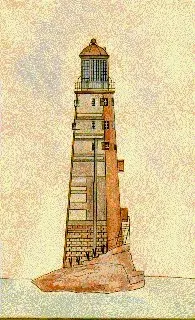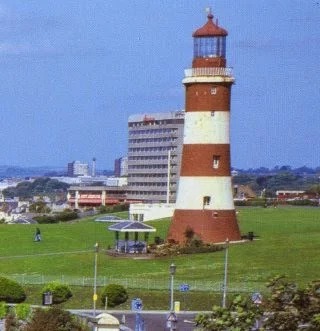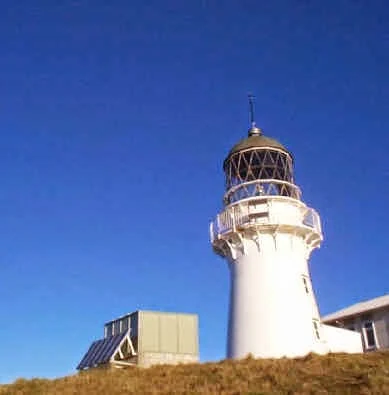When special stamps for use by the Government Life Insurance Office were first issued in 1891, a lighthouse was incorporated into the original design, the lighthouse being the emblem of the Life Insurance Office. The original design also carried the letters "V R" after the reigning Queen Victoria. Later issues of this design had the VR removed. Examples of these plus links to my pages on each of these are shown above.
In 1947 the old style Government Life Insurance stamps were replaced with a new series showing actual lighthouses. There were eventually eight stamps in this set. Seven were issued in 1947 and another one issued in 1963. These stamps used an effective two colour design to produce an attractive, and for its day, very modern appearance. Some of them also showed that light beam as had been a feature of the earlier Life Insurance stamps.
These first stamps were issued in the name of the Government Life Insurance Department, but under provisions of the Government Life Insurance Act, 1953, the name was altered to Government Life Insurance Office. The first stamp appearing under the new name was the 2 1/2d "Cape Campbell" issued on 4 November 1963.
1947 Lighthouse Issue.
½d - Castlepoint Lighthouse.
Castlepoint lighthouse, situated on the coast some 30 miles in a straight line east of Masterton, first came into use on 12 January 1913. South of the lighthouse is a prominent hill called 'The Castle' which gives the locality its name. Situated on a peninsula, that becomes almost an island at high tide, this light is important for vessels coming from the east which often made Castlepoint their New Zealand landfall.
1d - Taiaroa Lighthouse.
With gold being discovered in Central Otago, the city of Dunedin had quickly become one the more important ports of the young country of New Zealand. One of the earliest lighthouses erected in New Zealand, this light came into operation on 2 January 1865. Situated 58 metres above sea level at the southern side and seaward entrance to Otago Harbour, the Taiaroa Head Light guided shipping into Port Chalmers, the port for the city of Dunedin. The tower was built from stone quarried on the site.
2d - Cape Palliser Lighthouse.
This light, situated at the southern tip of the North Island, stands guard over the eastern approach to Cook Strait. It is set against the hillside above the rocky coastline and beach. There are over 250 steps to get up the base from the beach below.
The light first came into operation on 27 October 1897 and was originally fueled by oil. In 1954 the oil lamp was replaced with an electric one powered by a local diesel generator. This was subsequently replaced by a connection to the mains grid in 1967, although a diesel generator is retained for emergency power. The last keeper left the light in 1986 when it was fully automated. Now it is owned and operated by Maritime New Zealand and managed from a control room in Wellington.
Cape Palliser Lighthouse is one of three New Zealand lighthouses with a distinct striped paint scheme, in this case, red and white stripes; the other two are Dog Island Lighthouse, 1969 Lighthouse Issue, and Cape Campbell Lighthouse, 1963 Lighthouse issue further down this page, which both have black and white stripes.
.
3d - Eddystone Lighthouse.
1696 Winstanley Lighthouse. 1708 Lighthouse.
This is the most famous beacon on the British Coast is situated about 14 kilometres from the Cornish Coast, and 22 kilometres S.S.W. of Plymouth. The first lighthouse erected here was built of timber by Henry Winstanley in 1696 and enlarged and completed in 1699. In a great storm in 1703 the lighthouse was swept away, carrying with it its hapless architect and five keepers. In 1708 a new lighthouse of stone and wood was erected. Weathering storms for half a century it was eventually destroyed by fire but did become the prototype of all modern lighthouses.
A stone lighthouse was built in its place in 1759 which was in turn replaced in 1882 by the lighthouse depicted on the stamp. The tower is 40 metres high with a light visible for 28 kilometres. Notice in the modern photo below the roof above the light is now flat allowing a helicopter to land. Nearby is the base of an older lighthouse from 1759.
1759 Lighthouse. 1882 Present Lighthouse.
(Now rebuilt on land in Plymouth)
I know this is a famous lighthouse, said to be the prototype of all modern lighthouses, but I personally I believe they should have stayed with New Zealand lighthouses instead using one from England.
4d - Stephens Island Lighthouse.
This light positioned to guide shipping passing through Cook Strait, is situated off the northern tip of D'Urville Island and is approximately 96 kilometres in a direct line N.W. of Wellington and about the same distance N.E. of Nelson. It also marks the eastern entrance to Tasman Bay from the north. The powerful light came into operation on 29 January 1894.
The island featured in local myths as the place where a local lighthouse keeper's cat, named Tibbles, was claimed to have caused the extinction of the Stephens Island Wren in 1894. However, this belief was erroneous, an urban legend. While this cat did kill one of the last birds seen, a few more specimens were obtained in the following years, by which time the island also hosted numerous feral cats.
6d - The Brothers Lighthouse.
The Brothers is a group of small islands in Cook Strait, New Zealand, off the east coast of Arapawa Island. It comprises two main islands and a number of smaller islets. North Brother Island in this small chain is a sanctuary for the rare reptile species, the Brothers Island tuatara and is the site of the Brothers Island Lighthouse. Built about 70 metres above sea level the light came into operation on 24 September 1877. On the slopes below it, other buildings associated with the light can be seen. Today the light is automated so no keeper is required to live there. The remaining buildings are used by DOC staff and scientists visiting the island.
1/- Cape Brett Lighthouse.
Situated about 32 kilometres due east of Waitangi, Bay of Islands, Cape Brett lighthouse first came into operation on 21 February 1910. It was one of the first of its kind in New Zealand in which the light machinery revolved in a mercury float. The cast iron tower was made in New Zealand, the lantern, machinery and light apparatus being imported from Great Britain.
The island depicted on the stamp is Piercy Island. Through this island is a beautiful archway through which launches are able to navigate. I have been through this cave a few times when we have taken visitors to the Bay of Islands. They always enjoy the 'Hole in the Rock' cruise out to Cape Brett and Piercy Island.
Lighthouse Map.
Below is a New Zealand map showing the locations of the various lighthouses shown on Government Life stamps. See if you can find each of the seven lighthouses shown on the stamps above. For obvious reasons, Eddystone Lighthouse on the 3d stamp won't be found.
First Day Covers.
Two copies of 1947 Life Insurance First Day Covers.
The top one is on an official cover and the bottom one is a made-up cover.
1963 Lighthouse Issue.
(Issued 1963)
The 22 metre tall Cape Campbell lighthouse, guards the south-eastern approach to Cook Strait. Erected originally in 1870 as a timber structure, the tower was rebuilt in steel during 1905 and the lamp electrified in 1938.
This is the stamp that was issued much later in 1963. Notice the name change talked about above where the word 'department' was dropped in favour of 'office.' Because of the much shorter period, this stamp was used, it has become one of the more valuable in the series.
This is the 1963 First Day Cover of the 2½d - Cape Campbell Lighthouse. I believed this particular First Day Cover could be very rare as I had a lot of trouble finding it but the Stamps NZ catalogue (Link below) value this over at only $22.50.
Use of Government Life Insurance stamps.
1947 Life Insurance stamp, 2d Cape Palliser Lighthouse, on a commercial cover of the Napier Agency. Dated 3rd Oct 1952. An interesting question:- Is this James Berry, the famous stamp designer who actually designed this set too?
Not all Life Insurance mail carried stamps. Here is a 1951 Life Insurance orange & brown, postage paid permit cover 1 1/2d. It was used in Wellington, dated 23rd May 1951.
Technical information
Date of Issue:
| 1 August 1947 |
|---|---|
Designers:
| J Berry, Wellington |
Printer:
| Bradbury Wilkinson, England |
Stamp Size:
| 1/2d, 1d, 2d and 6d : 37mm x 21mm; 2 1/2d, 3d, 4d and 1s : 21mm x 37mm |
Sheet Size:
| 120 stamps per sheet |
Process:
| Recess printed - Intaglio |
Perforation Gauge:
| 13.5 |
Paper Type:
| St Cuthbert's 'Royal Cypher' grade, multiple NZ and star watermark |
Some of the images in this post were used with permission from the illustrated catalogue of StampsNZ
You can visit their website and Online Catalogue at, http://stampsnz.com/
Information for this post came from.

.%2B1d%2Bred..jpg)


























We appreciate your engagement with our content. To ensure a respectful and constructive community, please take note of the following:
- No Spam, Please: We do not tolerate spammy or promotional comments. Any such comments will be promptly removed.
- Moderation in Place: All comments are moderated to maintain a positive and inclusive environment. Please be patient, as it may take a little time for your comment to appear.
- Sign In with Google: To comment, please sign in using your Google account. This helps us maintain the integrity of our community and allows for better interaction.